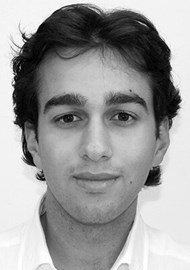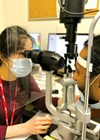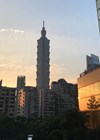The author explains how a research institute’s dedication to multidisciplinary collaboration helped him to discover a passion for academic ophthalmology.
The elective aspect to the final year of a medical degree, through its change of scenery and immersion into another culture, unites several aims on the path to becoming a more well-rounded and adaptable doctor.
My decision to study at the world renowned Institut de la Vision was motivated by a few key factors. My overarching ambition was to gain experience working in basic research; however, this was also an exciting opportunity for me to engage in a career in ophthalmology. Additionally, undertaking this programme in a foreign healthcare system facilitated a more personal challenge I set myself; to consolidate my fluency in speaking French, both in professional and conversational environments.

At the crossroads of neoclassicism and modernity, L’Institut de la Vision’s veranda:
the site of endless idea exchanges, usually with an espresso in hand.
Background
A formative period for me, early in medical school, was the chance to scrub in for a series of cataract operations. I was fascinated and wanted to learn more, which fuelled my engagement in various extracurriculars related to ophthalmology. Several clinical rotations, research projects, teaching assignments and administrative responsibilities as head of the ophthalmology society demonstrated that I wanted to pursue ophthalmology beyond medical school. All the while, these experiences simultaneously highlighted how much I enjoyed research; thus, I sought a vehicle by which to marry these two interests.
The six-week elective, therefore, was the perfect opportunity to learn more about a career in academic ophthalmology, and so I chose to undertake this in the research collaboration, The Institute of Vision (L’Institut de la Vision (IDV)) in Paris, France. The IDV and the associated Quinze-Vingts national ophthalmological hospital have several super-specialised research teams focusing on a range of topics, including physiopathology, neuron development and axonal messaging, gene therapies, stem-cell therapy, visual computation, and adaptive optical microscopy.
As I had previously conducted translational research into the chorioretinal effects of systemic inflammation [1], I reached out to Dr Florian Sennlaub, the team lead for research into age-related macular degeneration (AMD) and inflammation, seeking experience in basic research. The time constraints did not allow for independent completion of a project, so I was excited to observe and aid the team in pivotal components of their research.
While recent revision for finals ensured my clinical knowledge was at least up to date, chatting with my francophone friends highlighted that my grasp of the language had painfully deteriorated from au fait in secondary school, to un gros problème. With a renewed drive not to embarrass myself, I directed my academic focus to dusting off and revising grammar textbooks, practising my French vocabulary daily (or risk the mercy of intrusive app notifications), and joining a local medical-French language course.
Experience
Having studied in leafy Edinburgh for the past five years, upon arrival I realised I was woefully unprepared for rush hour in the fourth largest city in continental Europe. I quickly realised that the British penchant for queuing politely was not the Parisian way. Indeed, here, it was a survival disadvantage. Half an hour of respectfully ramping up my assertiveness later I was able to secure a combined bus / metro pass and begin navigating the complex and, to a foreigner, confusingly-signalled Parisian transport system, dodging an onslaught of electric scooters zooming past carrying with them the mumbled French utterances of angry commuters.

Microsurgical extraction of mouse retina and retinal pigment epithelium viewed under a microscope.

Success! Differential binding of antibodies on human tissue
demonstrated with an immunohistochemistry technique.
After several wrong turns, I found myself at the foot the IDV, an immense glass hive situated in the energetic district of Bastille. It stands sentinel over the red-brick arches of a disused railway viaduct which has been ingeniously converted into an elevated linear park and spaces for artisans’ studios, and neighbours the imposing Quinze-Vingts hospital (literally ‘fifteen twenties’, using a medieval counting system), whose significant historical presence has inspired philosophical writings and military accounts. It should, therefore, come as no surprise that the institute counts forward-thinking and collaboration amongst its values. Walking through the automatic doors, I was immediately humbled by the establishment I was entering.
The walls of the reception were adorned with vivid images of immunologically-labelled retinal cell cultures and enzymatically-isolated ganglion structures, and signs invited me to its four floors of dedicated ophthalmic research, an animal facility, French National Institute of Health and Medical Research offices, vision rehabilitation and restoration facilities, and Streetlab – an innovation hub for the development of technology for people with visual impairments.
Following several confused exchanges with the institute’s unfortunate receptionist, I was met by a member of the team who kindly offered me a tour of the lab facilities and overview of their research. Initially, what struck me was the ample lab space, state-of-the-art equipment, and fridges packed with tissue samples, culture isolates and expensive antibodies.
More inspiring, however, was the range of research the various biologists, pharmacists and engineers of the team were pioneering in AMD, diabetic retinopathy and retinal vein occlusion. The individual projects ranged from translational investigations into the relationship of ocular pathology with neurological conditions, basic research evaluating specific surface proteins as interventional targets for AMD and drugs to counter neovascularisation, as well as animal research attempting to establish the implication of synaptic signalling in the maladaptive propagation of retinal inflammation.
Having met the team and spent a few days familiarising myself with the state-of-the-art in the field of retinal inflammation, I was soon assisting experiments in immunohistochemistry, enzyme-linked immunosorbent assay (ELISA), polymerase chain reaction (PCR), white blood cell isolation, mRNA and plasmid extraction, cell culture and neovascular characterisation. By the second week, I was independently performing microsurgery on dissected mouse eyes to collect retinal and retinal pigment epithelium cell and tissue samples for the lab’s experiments. A change from my daily experiences back home and an exciting opportunity to conduct research first-hand.
I also took an interest in performing immunohistochemistry, a technique for imaging discrete components in tissues by using appropriately-labelled antibodies to bind specifically to their target antigens in situ [2]. In particular, I looked at the expression of Cluster of Differentiation 47 (CD47), a cell membrane protein crucial in cell signalling and apoptotic processes, in human tissue samples using various CD47-specific and leucocyte-binding antibodies described in the literature. After several experiments with immunofluorescence and enzyme-linked techniques, I received my most convincing results on the last day of my placement, clearly demonstrating a difference in the binding of different antibody mixtures and negative controls.

The Square du Vert-Galant; a river island oasis in the heart of Paris.
In addition to my laboratory experience, I attended several clinics in AMD, diabetic retinopathy, retinal vein occlusion, dry eye and rare genetic conditions in the Quinze-Vingts and Lariboisière hospitals, as well as a day of vitreoretinal and cataract surgery at the nearby Cochin Hospital. Even in these clinical settings, there was an active dialogue amongst ophthalmologists, opticians and ophthalmic nurses on initiatives to improve the service. For example, the aptly-named Docteur Video is an online educational platform for patients with details on several diseases and common operations, designed to encourage patients to engage with their conditions and discuss these with their healthcare practitioners. I also attended various seminars, research meetings, and a dynamic PhD defence across the various sites.

A crêpe farewell with the team.
All the while, I was undertaking this placement with the backdrop of an infamous city, steeped in history, that I had heard so much about, but finally got a chance to become familiar with. Faced with an unrivalled collection of museums and landmark attractions, I often found myself drawn to the Square du Vert-Galant, a tranquil, tree-lined garden enclosed within the triangular stern of the Île de la Cité. At the extreme point of the island is a small mound shaded by large willow trees, which offered a unique vantage point for observing the Seine as it flows through Paris whilst eating an invariably baguette-based lunch and reflecting on the day’s events.
Reflection
Ultimately, my experiences at the IDV provided an invaluable insight into the career of an academic ophthalmologist. It was a privilege to be introduced to such a motivated and friendly team who, through their patience and willingness to teach, helped me appreciate both the power but, at times, the frustration of basic research. Beyond textbooks and classroom discussions, I saw first-hand how scientific principles were applied to tackle biological problems and troubleshoot experimental failures. I appreciate the dedication and persistence necessary to see experiments through to the end, and trust in their success. I uphold the approachability of the team as that made this experience so enjoyable, and I learned the true value of a multidisciplinary research team.
It was interesting to see how most doctors in Paris adopted a slightly more paternalistic tone with patients than I had seen in Edinburgh. Talking to doctors, this seemed to be largely brought about by clinic time-pressures and the rigidity of a tick-box electronic health database interface that had been recently introduced. However, in my discussions with patients this approach to the doctor-patient relationship was largely amenable, as patients were relieved that their doctors took on more of the responsibility for decisions about their health, and some were impressed with the efficiency of the healthcare professionals. Indeed, this doctor-patient relationship did not stop patients from forming close relationships with their physicians, who they would often see every few months for intraocular injections or monitoring of disease progression.
Thanks to recent major reforms to health insurance in France, all legal permanent residents in France are entitled to state-subsidised healthcare if they have lived in the country for three consecutive months, with free healthcare available to low income or unemployed persons. However, I came across several patients, often visiting their relatives in the country, who lacked this cover and had to consider paying health premiums for their investigations or eye care. This was an uncomfortable and often distressing situation for all parties involved, which I had not been exposed to in the UK.
Although I was fascinated by the novel imaging and surgical techniques, especially the use of adjustable electromagnetic mirrors to obtain high-definition images of rod and cone cells in vivo using adaptive optics technology [3], the most memorable experiences were my conversations with patients and their families about the disabling effects of vision loss or ocular pain on their daily lives and wellbeing. I met several teenagers and young adults with genetic defects faced with the prospect of near-total vision loss before they were in their thirties, adults with refractory dry eye syndrome grappling with a life punctured with repetitive bouts of disabling eye pain, and even an elderly patient with deteriorating vision in his one remaining functional eye who was tasked with choosing between progressive blindness or risky surgery.
Perhaps my most memorable interaction was with a young child born with a unique variant of congenital stationary night blindness (CSNB) – an exceedingly rare, non-progressive disorder of the retina associated with myopia, nystagmus and strabismus, sometimes complicated by hearing and learning difficulties. The parents have been seeing specialists across the country, pleading for access to the latest research findings with the hopes of, perhaps one day, finding a treatment for the orphan disease. Finally, after years of searching, a glimmer of hope: an IDV collaboration with clinicians in Belgium has uncovered a novel mutation [4], and with it the potential of gene-targeted therapy. I am extremely privileged to have witnessed the smiles and respite that followed this news; I suspect, for the parents, the first in a long time. Even the kid seemed to light up, sensing the obvious delight in the room!
It was in these discussions that I truly appreciated the tremendous difference that eyecare professionals could make in society, as well as the sobering reality that further research is urgently needed for several ophthalmological conditions with very limited therapeutic options. Over time, I came to appreciate that the true wealth of the institute lay in its interdisciplinary collaboration between researchers and clinicians, and its outward focus.
Overall, both clinical and academic experiences greatly complemented each other, and I am grateful to my team for the opportunity to experience these. I would recommend the experience wholeheartedly to other students considering a career in ophthalmology or research. For my part, the enthusiasm and mentorship of my colleagues in Paris has galvanised me to pursue research into the immunological basis of ocular disease in Newcastle. À Bientôt, Paris!
References
1. Tzoumas N, Farrah TE, Dhaun N. Assessment of retina and choroid using optical coherence tomography in health, hypertension and chronic kidney disease [abstract]. Abstracts from the Royal College of Physicians of Edinburgh Medical Research Symposium for Students and Foundation Doctors 2018; Abstract 4. Available from:
www.rcpe.ac.uk/
sites/default/files/
medical_research_abstracts.pdf
Last accessed August 2019.
2. Overview of Immunohistochemistry. Thermofisher.com 2019; [cited 09 August 2019]. Available from:
https://www.thermofisher.com/uk/en/
home/life-science/protein-biology/
protein-biology-learning-center/
protein-biology-resource-library/
pierce-protein-methods/
overview-immunohistochemistry.html
Last accessed August 2019.
3. Paques M, Meimon S, Rossant F, et al. Adaptive optics ophthalmoscopy: Application to age-related macular degeneration and vascular diseases. Progress in Retinal and Eye Research 2018;66:1-6.
4. Tourville A, Michiels C, Condroyer C, et al. Identification of a novel GRM6 mutation in a previously described consanguineous family with complete congenital stationary night blindness. Ophthalmic Genetics 2019;40:182-4.
Further reading
- The Institute of Vision website: www.institut-vision.org/en/
- Streetlab: www.institut-vision.org/en/facilities/streetlab-facilities.html
- Docteur Video: www.docteurvideo.com
COMMENTS ARE WELCOME












